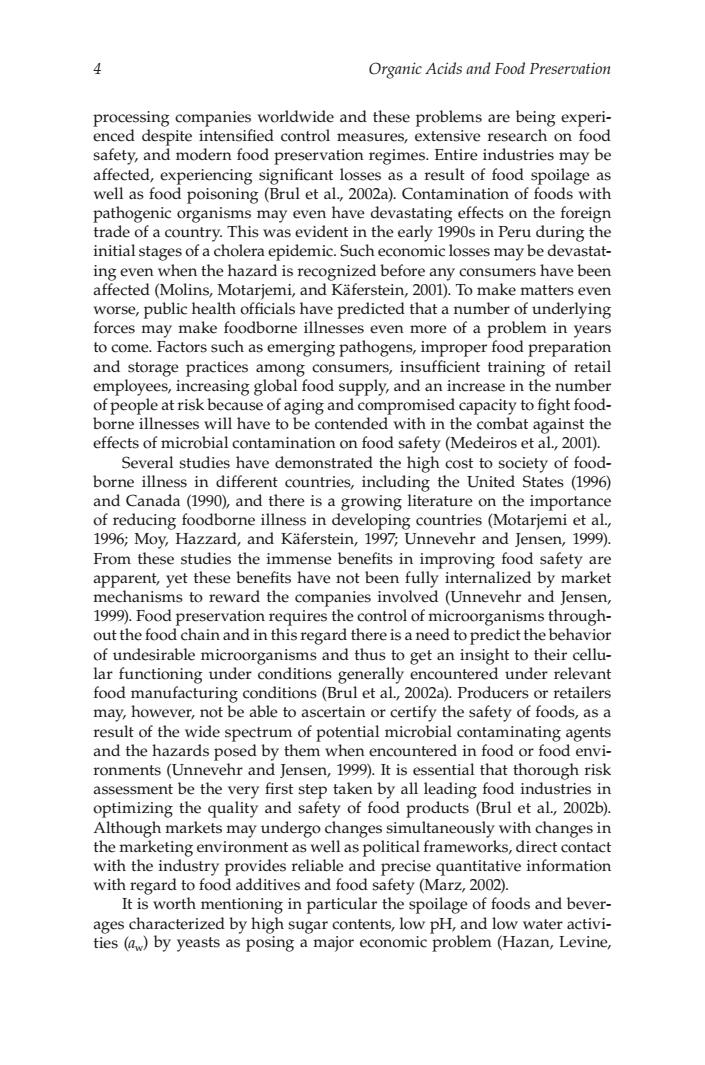正在加载图片...

Organic Acids and Food Preservation pro om worldwide and hesonfo enced de nd mode e food pre control meas ety, may be affected,experiencing significant losses as a result of food spoilage as well as food poisoning (Brul et al.,2002a).Contamination of foods with pathogenic organisms may even have devastating effects on the foreign trade of a country.This was evident in the early 1990s in Peru during the initial stages of a cholera epidemic.Such economic losses may be devastat- ing even when the hazard is recognized before any consumers have been affected(Molins,Motarjemi,and Kaferstein,2001).To make matters even worse,public health officials have predicted that a number of underlying forces may make foodborne illnes ses even more of a problem in years to come.Factors such as emerging pathogens,imp orag pra ctice sum employ asing gl food ndpply and a tra ncreas se or ill have to aging and capacity to fig ses conten with in t ag Several studies have demonstrated the high cost to society of food borne illness in different countries,including the United States (1996) and Canada(1990),and there is a growing literature on the importance of reducing foodborne illness in developing countries(Motarjemi et al., 1996;Moy,Hazzard,and Kaferstein,1997;Unnevehr and Jensen,1999). From these studies the immense benefits in improving food safety are leu ka pazteuiajur Allng uaaq iou sney sigauag asau ox quaredde mpanies involved(Unnevehr and Jense 1999)Food n the control of mic ic out the food chain a and in this rega need to dict the beha mi ms and thus o get an insi ight to their cellu neral under relevan food manufacturing conditions (Bru l et al,2002a) Producer or retailer may,however,not be able to ascertain or certify the safety of foods,as a result of the wide spectrum of potential microbial contaminating agents and the hazards posed by them when encountered in food or food envi ronments(Unnevehr and Jensen,1999).It is essential that thorough risk assessment be the very first step taken by all leading food industries in optimizing the quality and safety of food products (Brul et al.,2002b). Although markets may undergo changes simultaneously with changes in the marketing environr mont ac vell as olitical frameworks direct c ac with the ind rides reliable pr ntitative inforn mation with foo s and fo y T 2002 s worth ing in particular th ge of foods and bever ages characterized by high sugar contents,lo water activ ties (by yeasts as posing a maior economic problem (Hazan,Levine.4 Organic Acids and Food Preservation processing companies worldwide and these problems are being experienced despite intensified control measures, extensive research on food safety, and modern food preservation regimes. Entire industries may be affected, experiencing significant losses as a result of food spoilage as well as food poisoning (Brul et al., 2002a). Contamination of foods with pathogenic organisms may even have devastating effects on the foreign trade of a country. This was evident in the early 1990s in Peru during the initial stages of a cholera epidemic. Such economic losses may be devastating even when the hazard is recognized before any consumers have been affected (Molins, Motarjemi, and Käferstein, 2001). To make matters even worse, public health officials have predicted that a number of underlying forces may make foodborne illnesses even more of a problem in years to come. Factors such as emerging pathogens, improper food preparation and storage practices among consumers, insufficient training of retail employees, increasing global food supply, and an increase in the number of people at risk because of aging and compromised capacity to fight foodborne illnesses will have to be contended with in the combat against the effects of microbial contamination on food safety (Medeiros et al., 2001). Several studies have demonstrated the high cost to society of foodborne illness in different countries, including the United States (1996) and Canada (1990), and there is a growing literature on the importance of reducing foodborne illness in developing countries (Motarjemi et al., 1996; Moy, Hazzard, and Käferstein, 1997; Unnevehr and Jensen, 1999). From these studies the immense benefits in improving food safety are apparent, yet these benefits have not been fully internalized by market mechanisms to reward the companies involved (Unnevehr and Jensen, 1999). Food preservation requires the control of microorganisms throughout the food chain and in this regard there is a need to predict the behavior of undesirable microorganisms and thus to get an insight to their cellular functioning under conditions generally encountered under relevant food manufacturing conditions (Brul et al., 2002a). Producers or retailers may, however, not be able to ascertain or certify the safety of foods, as a result of the wide spectrum of potential microbial contaminating agents and the hazards posed by them when encountered in food or food environments (Unnevehr and Jensen, 1999). It is essential that thorough risk assessment be the very first step taken by all leading food industries in optimizing the quality and safety of food products (Brul et al., 2002b). Although markets may undergo changes simultaneously with changes in the marketing environment as well as political frameworks, direct contact with the industry provides reliable and precise quantitative information with regard to food additives and food safety (Marz, 2002). It is worth mentioning in particular the spoilage of foods and beverages characterized by high sugar contents, low pH, and low water activities (aw) by yeasts as posing a major economic problem (Hazan, Levine